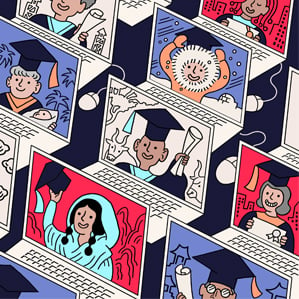Making Sense of
MOOCs
 |
| https://kumardeepak.files.wordpress.com/2013/03/mooc.png?w=490&h=294 |
At the end of
last semester I signed up for online courses (MOOCs) from Coursera and edX. Of
course, the beginning was spellbinding and interesting. I used to devote
specific time for it, maximum 2 hours for each before going to sleep. From the
second week I started to lose my interest and lagged behind my counterparts
from online learning. In third week I dropped the course finally. Experiencing this
all of this, I never took interest in the origin and function of the term MOOCs.
 |
| http://edudemic.com/wp-content/uploads/2012/09/moocs.jpg |
The term Massive
Open Online Courses (MOOCs) became a contemporary and often-used trend in
higher education dimension for the last several years. MOOCs is defined as a
distribution and assignation of course materials and instructors to students,
according to their specific interest or chosen themes (Yuan & Powell, 2013).
Essentially, it dates from 2007; and was invented as another alternative for
educational platform which was synchronized by the development of Open
Education (OE) movement and Open Education Resources (OER) (Yuan & Powell,
2013; Daniel, 2012).
Due to the distinct
pedagogical direction MOOCs was divided into cMOOCs – focusing on “connectivism
and networking” which articulates an interaction between a teacher and students
through technology and xMOOCs – emphasizes “behaviorist approach” articulating
less interaction but more content based with repetitive instructional methods
(Daniel, 2012, p. 2).
According to the
author’s given analysis and statistics, MOOCs courses, especially MITx, are considered
not venture or self-promotion, but responsible and sustainable human and education
development. It is seen from the attrition and registration rate to the MOOCs
courses, showing that to get the access to the courses is easy and everybody
can do, but the completion of the whole course indicates low percentage, which
means that to a great extension those who could accomplish are the only high
performed students.
Despite the
author’s statement that MOOCs attempts to include mass involvement of students throughout
the world and tries to address allegedly “everyone of any age and any time”, I believe
that some low-income families that cannot afford Internet or technical devices will
be disabled to learn through MOOCs, which again draws and glorifies elitism.
I liked the author’s
positive vision towards MOOCs in higher education sphere and his arguments
stating how and why it can be viable. However, I think it is just another
triumph of evolution of ICT in education and science development, which will be
replaced with other invention in the future.
References:
Daniel, J. (2012). Making Sense of
MOOCs: Musings in a Maze of Myth.Paradox and Possibility (MOOCs research
paper), retrieved January, 14,
2013.
Yuan, L., Powell, S., and CETIS, J.
(2013). MOOCs and open education: Implications for higher education. Cetis White Paper.

What an interesting post, Meru! And also well-informative for me as a person who also took several courses on Coursera, but never really thought about the origin of this type of education. I also dropped several courses on MOOCs, which I am not really proud of. Nevertheless, I find these courses extremely fascinating and resembling to the approach of flipped classroom, especially for people who can use their acquired skills and knowledge on practice at universities or schools. Nevertheless, I do not think that taking online courses can be comparable to the real education at universities. It is, probably, more about self-development and acquiring new skills which might be useful at work.
ReplyDelete